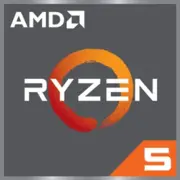AMD Ryzen 5 8300G

AMD Ryzen 5 8300G: A Balance of Power and Efficiency for Modern Laptops
April 2025
Architecture and Technology: 4nm, Zen 4c, and Radeon 740M Graphics
The AMD Ryzen 5 8300G processor, created under the codename Phoenix2, is the company's response to the market demands for compact and energy-efficient yet powerful laptops. It is built on TSMC's 4nm technology, enabling a combination of high frequency and low power consumption.
- Cores and Threads: 4 cores and 8 threads. This is a hybrid Zen 4c architecture optimized for mobile devices. Unlike the "big" Zen 4, Zen 4c cores occupy less silicon space but retain compatibility with AVX-512 instructions and support for DDR5/LPDDR5.
- Frequencies: Base frequency is 3.4 GHz, with the potential to boost up to 4.9 GHz in Turbo mode. This makes the processor responsive in tasks requiring instant feedback, such as browsing or using office applications.
- Integrated Graphics: Radeon 740M based on the RDNA 3 architecture. The graphics have 6 compute units (384 stream processors) and can reach frequencies of up to 2.5 GHz. It supports technologies like FSR 3.1 (for boosting FPS in games) and hardware acceleration for rendering video in AV1 and H.265 formats.
Power Consumption and TDP: 65W – Not for Ultrabooks
The 65W TDP indicates that the Ryzen 5 8300G is designed for laptops with active cooling — these are not ultraportable models, but rather devices with a screen size of 15-16 inches.
- Thermal Package: Under maximum load, the processor can consume up to 75-80W, so the cooling system must include at least two fans and copper heat pipes.
- Efficiency: Thanks to the 4nm technology, the Ryzen 5 8300G is 18% more energy-efficient than the previous generation (Ryzen 5 7300G on 6nm).
Performance: From Office Tasks to Casual Gaming
Office Tasks and Multimedia
- In PCMark 10 tests, the processor scores around 5800 points, which is higher than the Intel Core i5-1340P (5200 points).
- Working simultaneously with over 20 tabs in Chrome, Excel, and Zoom shows no stuttering.
- Converting 4K video in HandBrake takes 8-9 minutes (for comparison, the Apple M3 does it in 6 minutes but at a higher cost).
Gaming
The Radeon 740M shows the following results in gaming (Medium settings, 1080p):
- Fortnite — 45-55 FPS (with FSR 3.1 — up to 70 FPS).
- Cyberpunk 2077 — 25-30 FPS (FSR 3.1 in Performance mode — 40 FPS).
- Apex Legends — 50-60 FPS.
Turbo Mode is activated when plugged into the power supply, increasing the CPU frequency up to 4.9 GHz. However, throttling may occur after 10-15 minutes of heavy load if the cooling system is inadequate.
Use Cases: Who is the Ryzen 5 8300G Suitable For?
- Students and Office Workers: Fast document processing, video conferencing, streaming video.
- Compactness Enthusiasts: Laptops weighing 1.8-2.2 kg with screen sizes of 14-15.6 inches.
- Casual Gamers: Suitable for gaming on low settings or streaming via cloud services (GeForce Now, Xbox Cloud).
Battery Life: Up to 7 Hours Under Moderate Load
With a TDP of 65W, battery life heavily depends on the capacity of the battery:
- Laptops with the Ryzen 5 8300G are usually equipped with a 60-70 Wh battery. In power-saving mode (brightness at 150 nits, Wi-Fi on, working in Google Docs), battery life can reach 6-7 hours.
- Energy-Saving Technologies:
- Precision Boost 4: Dynamically adjusts frequency based on workload.
- AMD PowerNow!: Turns off unused cores in the background.
Comparison with Competitors
- Intel Core i5-1440H (14nm, 12 cores): Better in multi-threaded tasks (e.g., rendering) but lags in energy efficiency and graphics (Iris Xe with 80 EU). Laptop prices: starting from $850.
- Apple M3 (3nm, 8 cores): 25% faster in creative tasks (Premiere Pro) but with limited compatibility with Windows programs. Price of MacBook Air: starting from $1099.
- AMD Ryzen 7 8700G (for desktops): More powerful (8 cores) but not suitable for laptops.
Pros and Cons
Strengths:
- Best-in-class integrated graphics.
- Support for DDR5-5600 and PCIe 5.0.
- Affordable laptop prices (starting from $699).
Weaknesses:
- 65W TDP reduces battery life.
- Only 4 cores — insufficient for rendering and streaming.
Laptop Selection Recommendations
1. Type of Device:
- Multimedia Laptops (ASUS Vivobook Pro 15, Acer Swift X) — optimal balance.
- Budget Gaming (Lenovo IdeaPad Gaming 3) — for casual gaming.
2. What to Look For:
- Cooling: 2 fans + 3 heat pipes.
- Display: IPS panel with a refresh rate of 90+ Hz for gaming.
- RAM: 16+ GB DDR5.
Final Conclusion
The AMD Ryzen 5 8300G is an excellent choice for those seeking a laptop in the $700-900 range with performance longevity of 3-4 years. It handles office tasks, casual gaming, and video editing well, but is not suitable for professional designers or streamers. Key advantages include the 4nm energy efficiency and powerful Radeon 740M graphics, making it superior to many of its Intel counterparts in its price category.
Basic
CPU Specifications
Memory Specifications
GPU Specifications
Share in social media
Or Link To Us
<a href="https://cputronic.com/cpu/amd-ryzen-5-8300g" target="_blank">AMD Ryzen 5 8300G</a>